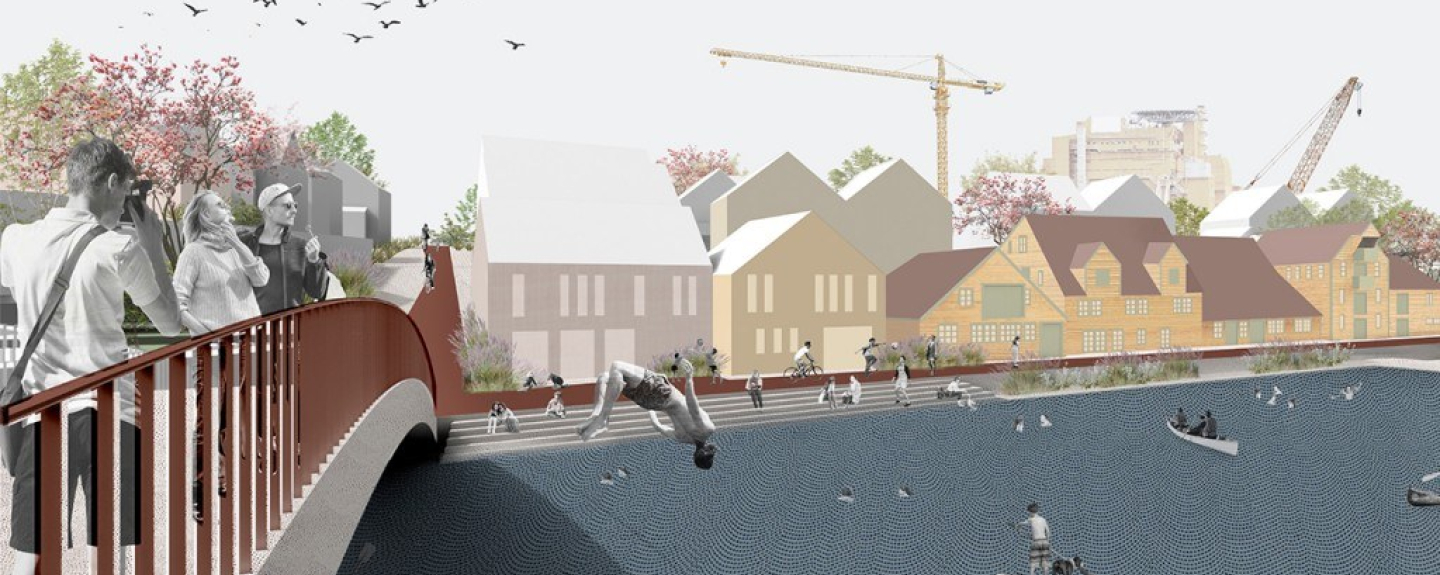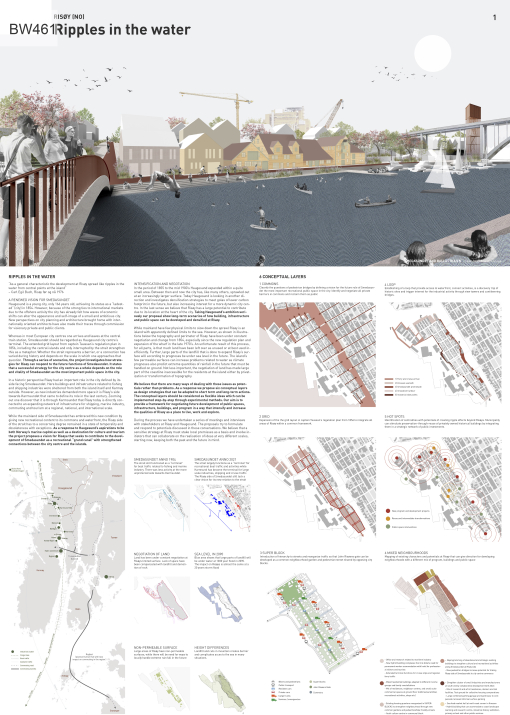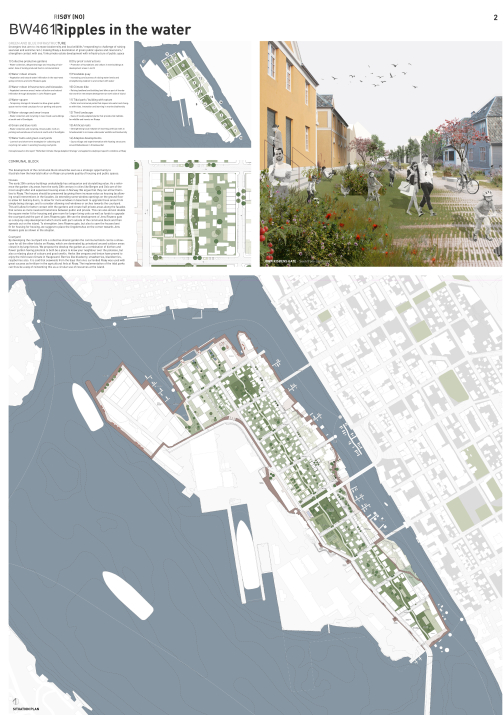Project:
Ripples in the water

About
-
The project approaches the task by first defining a renewed vision for Smedasundet as a recreational grand canal. It states that a successful strategy for the city centre as a whole depends on the role and vitality of Smedasundet as the most important public space in the city.Through a series of scenarios, it investigates how developments at Risøy can contribute to this vision while it also takes advantage of a stronger integration in the city to spark social and economic investments in its internal neighbourhoods and public spaces.As a design response, the project proposes six conceptual layers that can be adapted to short term and long-term actions. The conceptual layers should be considered as flexible ideas that can be implemented step-by-step and through experimental methods in collaboration between local authorites, private developers and residents.
-
The main idea in this winning concept is to connect the island of Risøy closer to the mainland of Haugesund. The strength of the proposal is the clear and convincing plan that underlines this connection, and utilises the unused qualities of Risøy as an asset to both Risøy and the town of Haugesund. The grid layout from the old street structure from 1856, only cut off by Smedsundet, is used and further developed to integrate the two parts in a common structure and framework. There is a clear visual and physical connection between the east-west streets or commons and the mainland. The commons end in different hotspots; two temporary bridges and a pier with a ferry connection. Smedsundet is activated as a recreational grand canal. The role of the water in a biodiversity perspective is considered and understood. The coherent promenade around the island and access to the waterfront is also important in this perspective, a reason to cross the canal and explore Risøy. The promenade is connected to the cruise area with a bridge, also giving the cruise passengers a better welcome to both Risøy and Haugesund.
The street pattern north-west is also well organized with traffic in Sundgata and the road next to Aibel, and John Risøys street as a green road for pedestrians and a common neighbourhood garden shared by the opposite blocks of houses. This undulating green street also connects the two main parks, one in the north and one in centre by the main bridge, and establishes a readable and well-defined green structure.The early phase actions are good. The development of the communal block as a strategic opportunity and tool to show how the structure of the existing buildings can provide quality of housing and public spaces, is well illustrated. The existing buildings in the mid area have a great potential to be attractive to younger families both as a result of the improved urban structure and the antiquarian qualities of the houses. It is important to allow small interventions in the facades, mainly to get better contact with the gardens and also to create half private areas along the facades and establish a more nuanced transition between public and private space. The proposal shows a potential for densification all over the island. -
Associates:
Erlend Strønstad (NO), Agathe Monnet (FR), Ona Marija Auskelyte (LT), Ida Ve (NO), Olav Kildal (NO) – architects
Helgesens Gate 82 E, 0563 Oslo
e.stroenstad@gmail.com
Team interview
1. How did you form the team for the competition?
The team consists of 5 Oslo based architects from Norway, France, and Lithuania. The five of us had never worked together as a group before, but we all knew each other well either as professional colleagues in other offices or through personal relationships.
2. How do you define the main issue of your project, and how did you answer on this session main topic, Living cities?
The project starts by defining a renewed vision for Smedasundet, the strait that divides Risøy from the mainland, as a recreational grand canal. It states that a successful strategy for the city centre, as a whole, depends on the role and vitality of Smedasundet as the most important public space in the city. Through a series of scenarios, the project investigates how developments at Risøy can contribute to this vision while it also takes advantage of a stronger integration in the city to spark social and economic investments in its internal neighbourhoods and public spaces.
As a design response, the project proposes six conceptual layers that can be adapted to short term and long-term actions. With these layers the project aims to both improve the quality of life at Risøy and to strengthen the integration of Risøy with the mainland city centre. 1) Reclaiming the commons to provide continuous public spaces from neighbourhoods to waterfronts, 2) Expand existing grid structure to integrate all areas of Risøy in a shared framework with the city centre, 3) Reorganize housing quarters into “super blocks” to extend common recreational areas, 4) Establish a pedestrian “loop” at the perimeter of the site that provide better access to waterfront and connect public spaces and functions at the island, 5) Define centralities at the islands as “hot spots” for private/public investments, 6) Strengthen existing character of neighbourhoods with mixed inhabitants and content. The conceptual layers should be considered as flexible ideas that can be implemented step-by-step and through experimental methods in collaboration between local authorities, private developers, and residents.
3. How did the issues on metabolic and inclusive vitalities and the questions raised by the site mutation meet?
Risøy had an important role in the urban development of Haugesund. The fishermen's houses that were concentrated along Smedasundet were among the first buildings in the city. The local economy based on fishing later diversified within maritime activities like barrel production and shipping. This gradually evolved into more space-demanding industries like the wharf that grew bigger along Karmsundet and connected local to global economy in a new dimension. A part of this urban development was self-grown, and solutions that once worked have now become obsolete and hinder inhabitants' use of the island. Today it results in local biotopes progressively disappearing on land and in the sea. The topography often prevents access to the coastline and doesn't respond to the contemporary challenge of rising sea level. In addition, the commons have been privatised, and the urban spaces don't meet today’s needs for neither Aibel nor the residents.
We understand metabolic urbanism as the study of how resources and underlying infrastructures are integrated in the planning of urban areas, and support their development instead of preventing it. For that reason, we based our work on a complete and thorough analysis of past and present situations, in order to establish a realistic vision for a more vital and inclusive Risøy.
We started our project by interviewing a wide number of stakeholders to understand the needs and ambitions on a local and regional scale: Risøy’s residents, Aibel, a professor in regional development, the director of the historical museum, local artists and architects, a botanist and a gardener.
We worked in parallel on understanding the historical geological layers, identifying the richness and fragilities of the local biotopes, as well as reflecting on what are the predominant or missing flows (pedestrians, cyclists, cars, boats) and functions (work, living, leisure, tourism). Our project aims to intensify and diversify interactions between all kinds of “inhabitants” on Risøy - people, animals, plants - by creating interwoven environments with clear transitions.
4. Have you treated this issue previously? What were the reference projects that inspired yours?
We have some experience from urban projects that have treated similar issues, however not in the same conceptual framework. To build our own approach in this project, we tried to combine readings of local history and site interviews with studies of visionary projects of architecture, landscape architecture, art, and planning. Some served as inspiration for the process and others as inspiration for physical implementation.
The ethnological research project carried out by Karmsund Folkemuseum at Risøy in 1976 was one of the first texts we read. The text gives a very rich description of Risøy both as a built and inhabited society. This has been influential to our approach at site while doing interviews and investigating the different environments at the island.
Further, the Superblock model of Barcelona has been an important reference to our work with flows and shared spaces in the housing quarters around John Risøens gate. It has also inspired our approach of experimental implementation through testing and participation in a long-time perspective.
To develop a holistic blue-green strategy that deals with complex topics such as regressing bio-diversities, raising sea level, and handling extreme rainfall we have looked towards plans and implementations in Rotterdam city. This is a place that really feels the changing conditions of climate and environment, and therefore have developed advanced and diverse strategies to deal with it.
To connect the topic of biodiversity and landscape to historical activities at Risøy readings of the French landscape architect Gilles Clément have been influential. We believe that future green spaces at Risøy should be guided through thoughtful “gardening” that provide diverse environments for locally adapted plants and insects.
Finally, we are very interested in the potential of art, both as a process and way of visualizing potentials through 1:1 implementation. In the Floating Pier project at lago Isea of Christo and Jeanne-Claude, we find strong inspiration to how temporary installations in the water could be used to test where future bridges and meeting places along Smedasundet should be built.
5. Urban-architectural projects like the ones in Europan can only be implemented together with the actors through a negotiated process and in time. How did you consider this issue in your project?
The project deals with this issue through combining long term visions, experimentation, and bottom-up strategies. The conceptual layer of the Superblock, as an example, is a long-term strategy for a more diversified and human centred transport and infrastructure system for the whole of Risøy. At the same time, it also includes an immediate bottom-up process of making one experimerimental, pedestrian friendly street. Through rerouting of traffic, redistribution of parking, establishing front gardens, building public furniture and arranging outdoor events and workshops, it sparks ideas about what can be done in the short term and implements actors as part of a process of transformation.
The conceptual layer of the Loop, as another example, is a vision and strategy for providing access to the waterfront, connecting activities, exploring historic sites, and triggering interest for industrial activity, both for inhabitants and visitors. The loop can be established through proposals from local artists on temporary projects that can identify and visualise the future loop. Building temporary floating footbridges at all commons during festivals in Haugesund can be a way of finding the best positions of future bridges and access to the waterfront. Competitions can be arranged to commission young architects and carpenters to design and build a floating sauna village. A collaboration project with Karmsund Folkemuseum and the wharfs to establish digital historical info points along the future loop, could also be a short term action and start of the future loop.
6. Is it the first time you have been awarded a prize at Europan? How could this help you in your professional career?
To most of us this was the first time to participate in a Europan competition. However, Erlend Aalmo Strønstad was part of a team that got awarded with “honourable mention” in Europan 11 for Haugesund (NO).
As a team we are young architects that have started our professional careers working in renowned Oslo based studios. Through our practice we have trained to design complex buildings where relations between architecture, urban context and local community is a key feature. To us, the relation between the city and architecture has therefore always been an influential interest. In this perspective we saw the Europan competition as an opportunity to develop our competence and approaches. The recognition of our thoughts and proposals by a highly experienced jury is of course very encouraging. We are now hoping that this award will lead to an exciting learning process, through site implementations in collaboration with local municipality and other stakeholders.
TEAM IDENTITY
Office: -
Function: architecture
Average age of the associates: 34 years old
Has your team, together or separately, already conceived or implemented some projects and/or won any competition? if yes, which ones
Our team members have implemented projects and won several competitions as employed in the offices where we have our daily practice. Independent of that experience our team members have implemented and been awarded with the following:
- 2021, Boathouses in Vindafjord kommune, built project, AGATHE and ERLEND in collaboration with Kolab and Mestres Wåge, winner of Vindafjord municipality architecture prize 2021.
- 2020, Summer cabin bay pier in Norway, built project, ONA and Peter Geelmuyden Magnus
- 2017, Boathouses in Karmøy kommune, built project, AGATHE and ERLEND in collaboration with Holon, winner of Karmøy municipality architecture prize 2021
- 2016, Hurdal Eco village. 27 dwellings in Norway´s first large scale eco village. Built project, OLAV with Eirik Fonn and Kasper Lundgaard.
- 2014, Annex in Birkeland, built project, ERLEND in collaboration with Haavard Tveito.
- 2013, Cabin in Selbu, ”Aarhønehytta”, IDA and OLAV, winner of the Norwegian wood building of the year award 2013.
- 2011, Europan 11 Haugesund, ERLEND in collaboration with Mestres Wåge and Leonor Migueis, awarded “honourable mention”
Related projects
-

The third space
The Third Space brings these users and functions together in the heart of the island and divides…
-

Ripples in the water
Through a series of scenarios, the project investigates how developments at Risøy can contribute to…
-

Life in all its settings
We propose to implement a new recreational connection on the edge of Risøy. The Risøy Route has…


